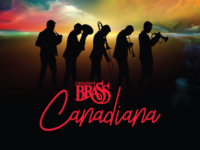On the 1st of July 2017, Canada celebrated the 150th anniversary of its founding as a nation. (That’s the sesquicentennial, for those of you fond of increasing your vocabulary.) These sorts of milestones are often times when the citizenry instinctively reflect on the state of nation, its place in history and its role in the future.
However, as part of the national character, it seems that Canadians are perpetually trying to define what that national character might actually be. This becomes particularly difficult when discussing Canadian culture. After all, the United States of America is just a step over the border, and its highly influential arts and entertainment industry just can’t be ignored.
Of course, popular music is a very important aspect of popular culture, and Canadians have been pondering for decades what elements might define Canadian music. In the early 1970s, there was even an attempt to bolster radio play for Canadian artists and music producers when the Canadian Radio-Television and Telecommunication Commission (CRTC for short) decreed that a certain percentage of music played during peak listening hours had to feature Canadian artists or production credits. Some saw this as government interference; others saw this as a boon for the fledgling Canadian music industry.
It seems to have worked: in 1967, only one Canadian artist made the Canada Top 100 for the year. (The Young Canada Singers performing Bobby Gimby’s centennial song “Canada!” made it to No. 41.) Since then, a lot of Canadian artists have gone on to worldwide acclaim, so it’s hard to argue with the results.
But there still seems to be no consensus as to what exactly defines Canadian music in any concrete way.
Recently, a University of Alberta music professor and his undergraduate student commented that the Tragically Hip, often awarded the title “Canada’s Band” by numerous music fans, actually had a lot of ambiguity in their lyrics. This basically allowed listeners to hear read anything they wanted into the songs, specifically as it relates to Canadian cultural identity. The internet was soon lit up by more than a few disgruntled Tragically Hip supporters that opposed this opinion, sarcastically labelling the originators as “intellectuals” and “academics,” meanwhile totally ignoring the fact that lead singer Gord Downie was himself a graduate of Queen’s University in Ontario.
In other words, there is still no clear definition of Canadian music, other than it’s different from American music, British music, or any other generally definable popular music movement. Perhaps the sparse population spread out over a vast landscape means that Canadian popular music will always contain a sense of regionalism that negates any sort of forced nationalism. Or maybe it’s just that putting up with the legendarily long winter season means that Canadians have a lot of time to gaze at their collective navels and ponder their country’s place in the world.
In any case, “50 from 50, Canadiana 1967-2017” collects 50 songs released by Canadian artists somewhere in the 50 years between 1967 and 2017. A list of 150 from the last 150 years is beyond most people’s interest, and the decision to make “O Canada” the national anthem over the much catchier “The Maple Leaf Forever” is a done deal. To further whittle down the list, solo artists have been mostly ignored, as well as French-language artists, though both groups have contributed much to the Canadian music industry.
50 from 50, Canadiana 1967-2017 is mostly a classic rock catalogue with a few twists, but if you don’t like it, fine – come up with your own playlist, and if you’re young enough, start thinking about 200 songs for the bicentennial coming up in 2067. Maybe there’ll be a working definition of Canadian music by then, unless global warming forces everyone out of their igloos.
With random commentary, and in no particular order:
“These Eyes” – The Guess Who
“Takin’ Care of Business” – Bachman-Turner Overdrive
“Blow at High Dough” – The Tragically Hip
“Limelight” – Rush
“If It Feels Good Do It” – Sloan
“Wild Eyes” – The Stampeders
“Chest Fever” – The Band
“Hey Maria” – Andrew Cash & the Little Ones: Founding member of Toronto punk band L’Etranger and the Cash Brothers, Andrew Cash was elected as a Member of Parliament in the 2011 federal election.
“Carrie” – Cano
“I’m an Adult Now” – The Pursuit of Happiness
“Battle Scar” – Max Webster: This particular entry in our 50 from 50, Canadiana 1967-2017 list is actually a band duet pairing up the four-piece Max Webster with Canada’s pre-eminent rock trio, Rush.
“Thru the Curtain” – Red Rider
“Action” – Streetheart
“Roxy Roller” – Sweeney Todd
“Julianna” – Five Man Electrical Band: “Signs” might be the bigger hit, but “Julianna” better displays the singing and arrangements of a very talented band.
“Let’s Shake” – Teenage Head
“Nice to Luv You” – 54.40
“Cuts Like a Knife” – Bryan Adams
“Cocaine Cowgirl” – Matt Mayes & El Torpedo
“Neighbourhood #1” – The Arcade Fire
“Just Came Back” – Colin James
“The Duckworth Stomp” – Thundermug
“Born to Be Wild” – Steppenwolf: Canadian ex-pats who made their name after moving to California.
“Gaslight” – The Ugly Ducklings
“All of the Time” – Trooper
“Gas Money & Cigarettes” – Goddo: We selected a later song for 50 from 50, Canadiana 1967-2017, but it encapsulates the oddball humor of their best work.
“Suzanne” – Leonard Cohen
“Free Man in Paris” – Joni Mitchell
“I’m Shattered” – Barney Bentall & the Legendary Hearts
“Rainbow Ride” – Andy Kim
“Not Ready to Go” – The Trews
“Could Have Been a Lady” – April Wine
“Snowbird” – Anne Murray: The godmother of a whole phenomenon one could call Canadian Female Singers, which could include such megastars as Celine Dion, Shania Twain, Avril Lavigne, Alanis Morissette, and Jann Arden, to name a few.
“Rocky Mountain Way” – Triumph
“Spaceship Superstar” – Prism
“Fly at Night” – Chilliwack
“Bud the Spud” – Stompin’ Tom Connors: A solo act, loved by everyone. Who else could get away with writing a song about potatoes?
“Last Song” – Edward Bear
“One Fine Morning” – Lighthouse
“Where Evil Grows” – The Poppy Family
“Some Sing, Some Dance” – Pagliaro
“The Wreck of the Edmund Fitzgerald” – Gordon Lightfoot
“Oh What a Feelin’” – Crowbar
“Helpless” – Neil Young: Another ex-pat, whose song about a “town in north Ontario” never fails to evoke the Canadian wilderness.
“Brian Wilson” – Barenaked Ladies
“Don’t Expect a Reply” – The Blue Shadows
“Rainbow Ride” – Andy Kim
“This Beat Goes On/Switchin’ to Glide” – The Kings
“Hey, Adrienne” – Library Voices
“Diamond Mine” – Blue Rodeo
- How David Bowie’s ‘The Next Day’ Stripped Away All of the Artifice - March 15, 2023
- Why Deep Purple’s ‘Who Do We Think We Are?’ Deserves Another Listen - January 11, 2023
- In Defense of the Often-Overlooked Mott the Hoople - November 10, 2022



